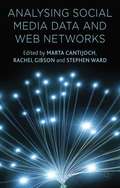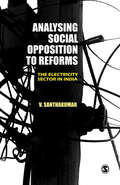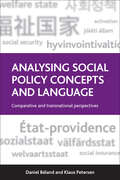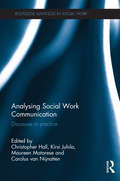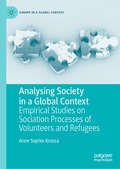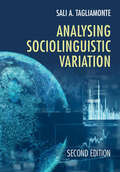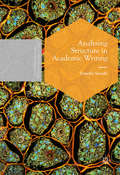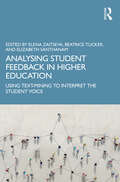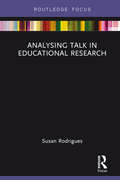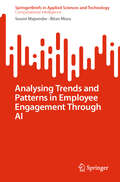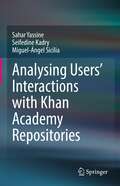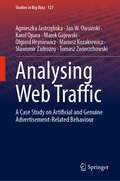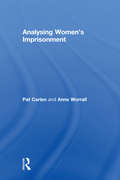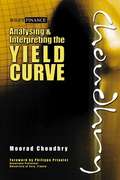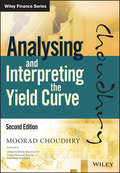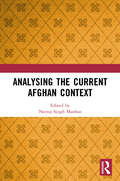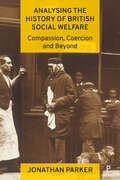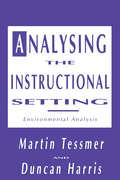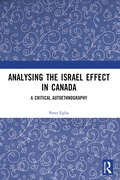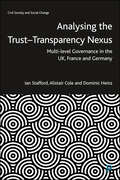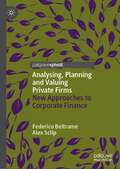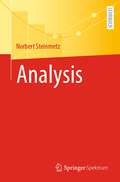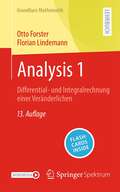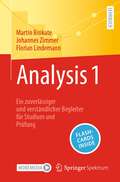- Table View
- List View
Analysing Social Media Data and Web Networks
by Rachel Gibson Stephen Ward Marta CantijochAs governments, citizens and organizations have moved online there is an increasing need for academic enquiry to adapt to this new context for communication and political action. This adaptation is crucially dependent on researchers being equipped with the necessary methodological tools to extract, analyze and visualize patterns of web activity. This volume profiles the latest techniques being employed by social scientists to collect and interpret data from some of the most popular social media applications, the political parties' own online activist spaces, and the wider system of hyperlinks that structure the inter-connections between these sites. Including contributions from a range of academic disciplines including Political Science, Media and Communication Studies, Economics, and Computer Science, this study showcases a new methodological approach that has been expressly designed to capture and analyze web data in the process of investigating substantive questions.
Analysing Social Opposition to Reforms: The Electricity Sector in India
by V. SanthakumarThis book examines how market contexts shape the opposition of people to public sector reforms, with evidence from the Indian electricity sector. Based on a survey of 7,000 households in 14 Indian states and following a rational choice framework, it analyses the response of households to the prospect of privatization of electricity utilities. Analysing Social Opposition to Reforms: The Electricity Sector in India discusses the possibility of compensating losers and sequencing reform strategies. It uses empirical evidence from the Indian electricity sector to suggest that much of the opposition can be explained in terms of the (short term) losses due to reforms. The book uses insights gained from Indian data to discuss the likelihood of opposition to reforms in other public services and also to examine the performance of electricity reforms in other Asian countries. It is one of the few empirical studies on how gains and losses affect opposition/support to economic/institutional reforms globally and as such is a valuable contribution to development studies, political economy and governance. The book will be of great interest to development professionals, policy makers and researchers.
Analysing Social Policy Concepts and Language: Comparative and Transnational Perspectives
by Daniel Béland and Klaus PetersenSocial policy scholars and practitioners work with concepts such as “welfare state” and “social security” but where do these concepts come from and how has their meaning changed over time? Which are the dominant social policy concepts and how are they contested? What characterises social policy language in specific countries and regions of the world and how do social concepts travel between countries? Addressing such questions in a systematic manner for the first time, this edited collection, written by a cross-disciplinary group of leading social policy researchers, analyses the concepts and language used to make sense of contemporary social policy. The volume focuses on OECD countries located on four different continents: Asia, Australasia, Europe, and North America. Combining detailed chapters on particular countries with broader comparative chapters, the book strikes a rare balance between case studies and transnational perspectives. It will be of interest to academics and students in social policy, social work, political science, sociology, history, and public administration, as well as practitioners and policy makers.
Analysing Social Work Communication: Discourse in Practice (Routledge Advances in Social Work)
by Kirsi Juhila Carolus Van Nijnatten Christopher Hall Maureen MatareseWith communication and relationships at the core of social work, this book reveals the way it is foremost a practice that becomes reality in dialogue, illuminating some of the profession’s key dilemmas. Applied discourse studies illustrate the importance of talk and interaction in the construction of everyday and institutional life. This book provides a detailed review and illustration of the contribution of discourse approaches and studies on professional interaction to social work. Concentrating on how social workers carry out their work in everyday organisational encounters with service users and colleagues, each chapter uses case studies analysing real-life social work interactions to explore a concept that has relevance both in discursive studies and in social work. The book thus demonstrates what detailed discursive studies on interaction can add to professional social work theories and discussions. Chapters on categorization, accountability, boundary work, narrative, advice-giving, resistance, delicacy and reported speech, review the literature and discuss how the concept has been developed and how it can be applied to social work. The book encourages professional reflection and the development of rigorous research methods, making it particularly appropriate for postgraduate and post-qualifying study in social work where participants are encouraged to examine their own professional practice. It is also essential reading for social work academics and researchers interested in language, communication and relationship-based work and in the study of professional practices more generally.
Analysing Society in a Global Context: Empirical Studies on Sociation Processes of Volunteers and Refugees (Europe in a Global Context)
by Anne Sophie KrossaThis book is the empirical part of a broad research project on society in a global context, complementing the first, theoretical book, Theorizing Society in a Global Context. While the theoretical book set the framework for a long overdue readdressing of the sociological core-term society in a conflict-theoretical perspective, this second book substantiates its findings with theory-driven empirical analysis. Krossa investigates a variety of social exchanges between refugees and longer-term residents using various qualitative methods, and applies a lens of inclusion and exclusion via definitions of dirt and cleanliness, to analyse the ways in which conflict-prone activities to ‘integrate’ take place. Analysing Society in a Global Context will be of interest to students and scholars across sociology, cultural studies, migration studies, European studies, globalisation studies, modern history, and political science.
Analysing Sociolinguistic Variation
by Sali A. TagliamonteNow in its second edition, this is an invaluable manual for teaching and learning variation analysis, the quantitative study of linguistic variation and change. Written by a leading scholar in the field with over thirty years of experience, it provides an insider's view of the methodology through practical, 'hands-on' advice, including straightforward instructions for conducting analyses using the R programming language, the new gold standard for analysis. It leads readers through each phase of a research study based on data gathered in sociocultural contexts, beginning with the selection and sampling of a data source, to hints on successful project design, interview techniques, data management, analysis and interpretation, with systematic procedures provided at each step of the process. This edition has been fully updated, with new insights and explanations in line with recent discoveries in the field, making it essential reading for anyone embarking on their own sociolinguistic research project.
Analysing Structure in Academic Writing (Postdisciplinary Studies in Discourse)
by Tomoko SawakiThis book breaks through formalistic traditions to propose a new generic structure analytical framework for academic writing. The integrated approach, taking lessons from cognitive linguistics and structuralism, offers a foundation for establishing research and pedagogy that can promote diversity and inclusion in academia. The simplicity of the flexible structure analytical model proposed by Sawaki enables the user to analyse diverse instances of genre. Further innovation is made in the analysis of generic structure components by integrating George Lakoff and Mark Johnson's metaphor analysis method, so that the model can account for cultural and ideological patterns that structure our abstract thinking. Using these integrations, the author has established a structure analytical model that can take into account linguistic, cognitive, and pragmatic aspects of genre. Researchers in the fields of linguistics, discourse studies, cultural studies, education, and English for Academic Purposes will be able to use this model to identify whether an atypical instance in academic texts is a result of the writer's individual failure or a failure to understand diversity in academic writing.
Analysing Student Feedback in Higher Education: Using Text-Mining to Interpret the Student Voice
by Elena Zaitseva Beatrice Tucker Elizabeth SanthanamAnalysing Student Feedback in Higher Education provides an in-depth analysis of ‘mining’ student feedback that goes beyond numerical measures of student satisfaction or engagement. By including authentic student voices for understanding the student experience, this book will inform strategies for quality improvement in higher education globally. With contributions, representing an international community of academics, educational developers, institutional data analysts and student-researchers, this book reflects on the role of computer-aided text analysis in gaining insight of student views. The chapters explore the applications of text-mining in different forms, these include varied institutional contexts, using a range of instruments and pursuing different institutional aims and objectives. Contributors provide insights enabled by computer-aided analysis in distilling the student voice and turning large volumes of data into useful information and knowledge to inform actions. Practical tips and core principles are explored to assist academic institutions when embarking on analysing qualitative student feedback. Written for a wide audience, Analysing Student Feedback in Higher Education provides those making informed decisions about how to approach analyses of large volumes of student narratives, with the benefit of learning from the experiences of those who already started treading this path. It enables academic developers, institutional researchers, academics, and administrators to see how bringing text mining to their institutions can help them in better understanding and using the student voice to improve practice.
Analysing Talk in Educational Research
by Susan RodriguesAnalysing Talk in Educational Research is the go-to guide for all educational researchers collecting data in the form of talk. Offering practical and helpful approaches alongside explanations of relevant theories, it is a thorough yet concise guidebook providing all the advice necessary to effectively analyse talk data. Examining talk analysis through the lens of three theoretical approaches – Systemic Functional Linguistics, Positioning Theory and Interpersonal Behaviour Theory – the book offers detailed summaries and analyses of these theories and also covers topics including: How to begin collecting talk data The ethical issues surrounding collecting talk data Appropriate strategies for transcription and coding Checking for trustworthiness and credibility of talk data. Each chapter includes provocation exercises and illustrative examples, as well as links to websites and further reading suggestions to deepen understanding. Guiding readers from the necessary practical considerations required during data collection through to final evaluations, Analysing Talk in Educational Research is essential reading for graduate students and academic researchers completing studies involving talk and looking for a quick and helpful introduction to the rigorous methods with which to analyse their data.
Analysing Trends and Patterns in Employee Engagement Through AI (SpringerBriefs in Applied Sciences and Technology)
by Soumi Majumder Bitan MisraThis book explores the concept of employee engagement, which is crucial for a company's success, as it is closely linked to job satisfaction and employee morale. Engaged workers tend to be more productive, efficient, and committed to the values and objectives of the company. Artificial intelligence plays a significant role in HR analytics, particularly in automating tedious tasks like data collection and organization from multiple sources. AI-driven employee engagement software can analyze employee feedback, surveys, and social media posts to capture the overall sentiment of the workforce. This allows HR teams to gain insights into employee experiences and perceptions, uncover areas for improvement, and address any issues that require attention. By leveraging past data and employing machine learning algorithms, AI enables HR professionals to predict turnover rates, forecast employee engagement levels, and identify potential flight risks.
Analysing Users' Interactions with Khan Academy Repositories
by Seifedine Kadry Sahar Yassine Miguel-Ángel SiciliaThis book addresses the need to explore user interaction with online learning repositories and the detection of emergent communities of users. This is done through investigating and mining the Khan Academy repository; a free, open access, popular online learning repository addressing a wide content scope. It includes large numbers of different learning objects such as instructional videos, articles, and exercises. The authors conducted descriptive analysis to investigate the learning repository and its core features such as growth rate, popularity, and geographical distribution. The authors then analyzed this graph and explored the social network structure, studied two different community detection algorithms to identify the learning interactions communities emerged in Khan Academy then compared between their effectiveness. They then applied different SNA measures including modularity, density, clustering coefficients and different centrality measures to assess the users’ behavior patterns and their presence.By applying community detection techniques and social network analysis, the authors managed to identify learning communities in Khan Academy’s network. The size distribution of those communities found to follow the power-law distribution which is the case of many real-world networks.Despite the popularity of online learning repositories and their wide use, the structure of the emerged learning communities and their social networks remain largely unexplored. This book could be considered initial insights that may help researchers and educators in better understanding online learning repositories, the learning process inside those repositories, and learner behavior.
Analysing Web Traffic: A Case Study on Artificial and Genuine Advertisement-Related Behaviour (Studies in Big Data #127)
by Sławomir Zadrożny Jan W. Owsiński Olgierd Hryniewicz Karol Opara Agnieszka Jastrzębska Marek Gajewski Mariusz Kozakiewicz Tomasz ZwierzchowskiThis book presents ample, richly illustrated account on results and experience from a project, dealing with the analysis of data concerning behavior patterns on the Web. The advertising on the Web is dealt with, and the ultimate issue is to assess the share of the artificial, automated activity (ads fraud), as opposed to the genuine human activity.After a comprehensive introductory part, a full-fledged report is provided from a wide range of analytic and design efforts, oriented at: the representation of the Web behavior patterns, formation and selection of telling variables, structuring of the populations of behavior patterns, including the use of clustering, classification of these patterns, and devising most effective and efficient techniques to separate the artificial from the genuine traffic.A series of important and useful conclusions is drawn, concerning both the nature of the observed phenomenon, and hence the characteristics of the respective datasets, and the appropriateness of the methodological approaches tried out and devised. Some of these observations and conclusions, both related to data and to methods employed, provide a new insight and are sometimes surprising. The book provides also a rich bibliography on the main problem approached and on the various methodologies tried out.
Analysing Women's Imprisonment
by Pat Carlen Anne WorrallIn both the UK and the rest of the world there have been rapid increases in the numbers of women in prison, which has led to an acceleration of interest in women's crimes and the social control of women, and women's experience of both prison and the criminal justice system is very different to men's. This text is concerned to address the key issues relating to women's imprisonment, contributing at the same time to an understanding of prison issues in general and the historical and contemporary politics of gender and penal justice. What are women's prisons for? What are they like? Why are lone mothers, ethnic minority and very poor women disproportionately represented in the women's prison population? Should babies be sent to prison with their mothers? These are amongst the issues with which this book is concerned. Analysing Women's Imprisonment is written as an introductory text to the subject, aiming to guide students of penology carefully through the main historical and contemporary discourses on women's imprisonment. Each chapter has a clear summary ('concepts to know'), essay questions and recommendations for further reading, and will help students prepare confidently for seminars, course examinations and project work.
Analysing and Interpreting the Yield Curve
by Moorad ChoudhryThe yield curve is the defining indicator of the global debt capital markets, and an understanding of it is vital to the smooth running of the economy as a whole. All participants in the market, be they issuers of capital, investors or banking intermediaries, will have a need to estimate, interpret and understand the yield curve. Fund managers that accurately predict the shape and direction of the curve will consistently outperform those that do not.This groundbreaking new book offers:An intuitive account of a very important technical subject, cutting through the mathematics to reveal key conceptsMarket approaches to enable fund managers to evaluate the current and expected shape of the yield curveAn opportunity for market professionals to have an understanding of the latest analytical techniques.Written by an experienced market practitioner, this book is a clear and accessible account of an important financial topic.
Analysing and Interpreting the Yield Curve (Wiley Finance)
by Moorad ChoudhryUnderstand and interpret the global debt capital markets Now in a completely updated and expanded edition, this is a technical guide to the yield curve, a key indicator of the global capital markets and the understanding and accurate prediction of which is critical to all market participants. Being able to accurately and timely predict the shape and direction of the curve permits practitioners to consistently outperform the market. Analysing and Interpreting the Yield Curve, 2nd Edition describes what the yield curve is, explains what it tells participants, outlines the significance of certain shapes that the curve assumes and, most importantly, demonstrates what factors drive it and how it is modelled and used. Covers the FTP curve, the multi-currency curve, CSA, OIS-Libor and 3-curve models Gets you up to speed on the secured curve Describes application of theoretical versus market curve relative value trading Explains the concept of the risk-free rate Accessible demonstration of curve interpolation best-practice using cubic spline, Nelson-Siegel and Svensson 94 models This advanced text is essential reading for traders, asset managers, bankers and financial analysts, as well as graduate students in banking and finance.
Analysing the Current Afghan Context
by Neeraj Singh ManhasAfghanistan is on the verge of another transition as it seeks stability and deals with a variety of internal and external issues. After the Taliban, an Islamic fundamentalist organisation, captured Kabul, Afghanistan’s capital, on August 15, 2021. It was the culmination of a military offensive against the Afghan government that began in May 2021. The arrest occurred just hours after President Ashraf Ghani fled the country. The majority of Afghanistan’s provincial capitals had fallen one after the other as part of a US troop withdrawal scheduled to end on August 31, 2021. Internal political turmoil, constant Taliban attacks across the country, and deadly suicide bombings by the Islamic State-Khorasan keep it busy while external nations play the New Great Game for geo-strategic ambitions both in its front yard and in its backyard. This book highlights all the ongoing issues of Afghanistan’s surge and provides the readers with insights into the country’s past, present and future. Print edition not for sale in South Asia (India, Sri Lanka, Nepal, Bangladesh, Pakistan and Bhutan).
Analysing the History of British Social Welfare: Compassion, Coercion and Beyond
by Jonathan ParkerThis book offers insights into the development of social welfare policies by exploring the interconnections between policies and practice throughout history. It challenges tacitly accepted arguments that favour particular approaches to welfare, such as conditionality and eligibility. It provides examples of enduring social assumptions which influence the way we perform social welfare, such as the equivocal position of women in social welfare and the unintended consequences of reforms such as Universal Credit. By identifying continuities in welfare policy, practice and thought, it offers the potential for the development of new thinking, policy making and practice.
Analysing the Instructional Setting: A Guide for Course Designers
by Duncan Harris Martin TessmerDesigned to overcome flaws during the planning and design stages of educational or training courses, this guide explains the importance of physical factors in the instructional environment, the roles of the instructor and learner, and the gathering of information on the learning environment.
Analysing the Israel Effect in Canada: A Critical AutoEthnography
by Peter EglinWhat is the life of a Palestinian worth to intellectuals in Canadian universities and news media? Analyzing the Israel Effect documents and analyzes the discursive and organizational methods by which public criticism of Israel’s oppression of the Palestinians is silenced in Canada, as experienced through ten episodes in the life of the author over a thirty-year period from 1990-2020 in interaction with his university and local and national Canadian news media.As a sociological work the book is a critical autoethnography. But it is also an atrocity tale, a horror story of institutional self-censorship amounting to the abrogation of intellectual responsibility by those specifically charged with upholding it. In the end, the book is a crossover between academic treatise and journalistic exposé, “a historical narrative written by an academic from the standpoint of a political participant-observer” (Rajan Philips). The Israel Effect itself is analyzed as a three-tier propaganda industry. Hasbara is produced in Israel (Tier 1), disseminated to Israel Lobby groups around the world (Tier 2) and independently re-produced, actively and passively, by the “intellectual” institutions – universities and news media (Tier 3). This book is about the non-Jewish, non-Zionist institutions of Tier 3, the onlookers to war crimes, ethnic cleansing and, arguably, genocide, as in Gaza in October-November 2023.This work stands as a compelling testament to the importance of preserving freedom of expression, and the vital role intellectuals play in challenging injustice and promoting transparency. It is ideal for scholars, activists, and anyone seeking to understand the complexities of political activism and the power dynamics behind public discourse.
Analysing the Screenplay
by Jill NelmesMost producers and directors acknowledge the crucial role of the screenplay, yet the film script has received little academic attention until recently, even though the screenplay has been in existence since the end of the 19th century. Analysing the Screenplay highlights the screenplay as an important form in itself, as opposed to merely being the first stage of the production process. It explores a number of possible approaches to studying the screenplay, considering the depth and breadth of the subject area, including: the history and early development of the screenplay in the United States, France and Britain the process of screenplay writing and its peculiar relationship to film production the assumption that the screenplay is standardised in form and certain stories or styles are universal the range of writing outside the mainstream, from independent film to story ideas in Bhutanese film production to animation possible critical approaches to analysing the screenplay. Analysing the Screenplay is a comprehensive anthology, offering a global selection of contributions from internationally renowned, specialist authors. Together they provide readers with an insight into this fascinating yet complex written form. This anthology will be of interest to undergraduate and postgraduate students on a range of Film Studies courses, particularly those on scriptwriting.
Analysing the Trust–Transparency Nexus: Multi-level Governance in the UK, France and Germany (Civil Society and Social Change)
by Alistair Cole Ian StaffordIs transparency a necessary condition to build and restore citizen and civil society trust in governance and democracy? Throughout Europe, there is a growing demand for effective forms of citizen engagement and decentralisation in policy-making to increase trust and engage increasingly diverse populations. This volume addresses the relationship between trust and transparency in the context of multi-level governance. Drawing on fieldwork from the UK, France and Germany, this comparative analysis examines different efforts to build trust between key actors involved in decision-making at the sub-national level. It outlines the challenges of delivering this agenda and explores the paradox that trust might require transparency, yet in some instances transparency may undermine trust.
Analysing, Planning and Valuing Private Firms: New Approaches to Corporate Finance
by Federico Beltrame Alex SclipCorporate finance plays a vital role in every business as it pertains to an array of financing and investment decisions. Where most corporate finance books provide tools for public companies, this book presents new approaches and methods for planning and valuing private firms. Chapters discuss how typical valuation methods may not be perfectly adaptable to private firms and their investment decisions: in particular showing how the widely used Capital Asset Pricing Model cannot be precisely applied for the estimation of cost of equity for private companies, and the limitations of market multiples which may not match individual company features.The book suggests new ways of financial forecasting that can be better tailored to private businesses, such as by exploiting the concept of financial breakeven based on debt serviceability that departs from the more traditionally used concept of the revenue-cost breakeven. Topics including financial planning, working capital management, the cost of capital, and valuation methods are all covered. This book will be of interest to consultants, analysts and accountants working in private firms, as well as academics and students who are interested in an empirical assessment of the role of corporate finance in private businesses versus larger public companies.
Analysis
by Norbert SteinmetzDas Buch wendet sich sowohl an Studierende aller mathematischen Fachrichtungen und mathematisch interessierte Studierende der Physik als auch an Dozentinnen und Dozenten, die den Aufbau ihres ersten Analysiskurses noch vor sich haben oder Anregungen für ihre Vorlesungen suchen. Inhalt und Form sind entstanden und vielfach erprobt in immer wieder kritisch veränderten und angepassten 3-semestrigen Analysiskursen. Etwa 2/3 des Buches decken die Erfordernisse einer 2-semestrigen Grundvorlesung Analysis ab, wohingegen das restliche Drittel Elemente der Fourieranalysis, der Differentialgeometrie, der gewöhnlichen Differentialgleichungen und der Funktionentheorie behandeln, Themen, denen eigenständige Vorlesungen auch weiterhin zu wünschen sind. Zu den Besonderheiten zählen die parallele und miteinander verzahnte Einführung des Riemann- und Lebesgueintegrals, die Einbettung einfacher Elemente der komplexen in die reelle Analysis, ausgedehnte Anwendungen – von der Heisenbergschen Unschärferelation über die Lösung der Wärmeleitungsgleichung bis hin zur Black-Scholes-Formel – sowie die Darstellung der Methode von Ostrogradski und des Dixon-Beweises der allgemeinen Cauchyschen Integralformel. Dass an verschiedenen Stellen die eingefahrenen Pfade verlassen wurden, wird der kundigen Leserschaft nicht verborgen bleiben. Die Frage „abstrakt oder anschaulich-verständlich“ wird konsequent zugunsten des letzteren entschieden. Die Übungsaufgaben sind in den laufenden Text eingebaut in der Hoffnung, dass sie so mehr Beachtung finden. Schließlich vermitteln die historischen Anmerkungen und Kurzbiographien einen Eindruck davon, wie die Analysis sich entwickelt hat und wer wesentlich an dieser Entwicklung beteiligt war.
Analysis 1: Differential- und Integralrechnung einer Veränderlichen (Grundkurs Mathematik)
by Otto Forster Florian LindemannDieses fest etablierte Lehrbuch begleitet Studierende der Mathematik, Physik und Informatik seit über vier Jahrzehnten durch die Analysis des ersten Semesters. Es gelangt in systematischer Weise, aber ohne zu große Abstraktionen, einfach und verständlich zu den grundlegenden Begriffen (Konvergenz von Folgen und Reihen, Stetigkeit, Differentiation, Riemannsches Integral) und illustriert sie mit zahlreichen Beispielen. Die numerische Seite der Analysis wird an verschiedenen Stellen beleuchtet, um den Grenzwertbegriff konkreter zu machen. Das Buch schließt mit zwei Kapiteln über Taylor- und Fourier-Reihen, in denen alle bis dahin gelernten Techniken zum Einsatz kommen. Jedes Kapitel enthält Übungsaufgaben zum Vertiefen der Inhalte. Für die vorliegende Auflage wurde der Text einschließlich aller Abbildungen erneut überarbeitet. Darüber hinaus ergänzen nun elektronische Flashcards das Buch: Diese per App zugänglichen Verständnisfragen unterstützen den Lernprozess und eignen sich auch sehr gut zur Prüfungsvorbereitung.
Analysis 1: Ein zuverlässiger und verständlicher Begleiter für Studium und Prüfung
by Martin Brokate Florian Lindemann Johannes ZimmerZiel dieses Lehrbuchs ist es, das Material des ersten Semesters eines Vorlesungszyklus zur Analysis prägnant und verständlich darzustellen und darüber hinaus Ausblicke und Ergänzungen zu geben, die den Stoff lebendig werden lassen. Besonderer Wert wird auf die Motivation der zu behandelnden Themen gelegt. Zu Beginn des Buchs wird die mathematische Denkweise, insbesondere Beweistechniken und axiomatisches Vorgehen, ausführlich eingeführt. Dieses Buch basiert auf Vorlesungen, die regelmäßig und seit vielen Jahren an der TU München abgehalten werden. Zahlreiche Abbildungen veranschaulichen die behandelten Konzepte und Ideen. Zudem ermöglicht dieses Lehrbuch den Zugriff auf mehr als 250 interaktive Aufgaben in der Springer Nature Flashcards-App, mit denen Wissen und Verständnis überprüft werden kann – hervorragend geeignet auch zur Prüfungsvorbereitung.
